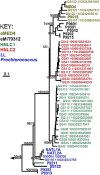Characterization of Prochlorococcus clades from iron-depleted oceanic regions
- PMID: 20733077
- PMCID: PMC2941326
- DOI: 10.1073/pnas.1009513107
Characterization of Prochlorococcus clades from iron-depleted oceanic regions
Abstract
Prochlorococcus describes a diverse and abundant genus of marine photosynthetic microbes. It is primarily found in oligotrophic waters across the globe and plays a crucial role in energy and nutrient cycling in the ocean ecosystem. The abundance, global distribution, and availability of isolates make Prochlorococcus a model system for understanding marine microbial diversity and biogeochemical cycling. Analysis of 73 metagenomic samples from the Global Ocean Sampling expedition acquired in the Atlantic, Pacific, and Indian Oceans revealed the presence of two uncharacterized Prochlorococcus clades. A phylogenetic analysis using six different genetic markers places the clades close to known lineages adapted to high-light environments. The two uncharacterized clades consistently cooccur and dominate the surface waters of high-temperature, macronutrient-replete, and low-iron regions of the Eastern Equatorial Pacific upwelling and the tropical Indian Ocean. They are genetically distinct from each other and other high-light Prochlorococcus isolates and likely define a previously unrecognized ecotype. Our detailed genomic analysis indicates that these clades comprise organisms that are adapted to iron-depleted environments by reducing their iron quota through the loss of several iron-containing proteins that likely function as electron sinks in the photosynthetic pathway in other Prochlorococcus clades from high-light environments. The presence and inferred physiology of these clades may explain why Prochlorococcus populations from iron-depleted regions do not respond to iron fertilization experiments and further expand our understanding of how phytoplankton adapt to variations in nutrient availability in the ocean.
Conflict of interest statement
The authors declare no conflict of interest.
Figures



Similar articles
-
Co-occurring Synechococcus ecotypes occupy four major oceanic regimes defined by temperature, macronutrients and iron.ISME J. 2016 Feb;10(2):333-45. doi: 10.1038/ismej.2015.115. Epub 2015 Jul 24. ISME J. 2016. PMID: 26208139 Free PMC article.
-
Novel lineages of Prochlorococcus and Synechococcus in the global oceans.ISME J. 2012 Feb;6(2):285-97. doi: 10.1038/ismej.2011.106. Epub 2011 Sep 29. ISME J. 2012. PMID: 21955990 Free PMC article.
-
Novel isolates expand the physiological diversity of Prochlorococcus and illuminate its macroevolution.mBio. 2024 Nov 13;15(11):e0349723. doi: 10.1128/mbio.03497-23. Epub 2024 Oct 18. mBio. 2024. PMID: 39422514 Free PMC article.
-
A minimum set of regulators to thrive in the ocean.FEMS Microbiol Rev. 2020 Mar 1;44(2):232-252. doi: 10.1093/femsre/fuaa005. FEMS Microbiol Rev. 2020. PMID: 32077939 Review.
-
Prochlorococcus: advantages and limits of minimalism.Ann Rev Mar Sci. 2010;2:305-31. doi: 10.1146/annurev-marine-120308-081034. Ann Rev Mar Sci. 2010. PMID: 21141667 Review.
Cited by
-
Cross-species transcriptional network analysis reveals conservation and variation in response to metal stress in cyanobacteria.BMC Genomics. 2013 Feb 19;14:112. doi: 10.1186/1471-2164-14-112. BMC Genomics. 2013. PMID: 23421563 Free PMC article.
-
Phylogenetic conservatism of functional traits in microorganisms.ISME J. 2013 Apr;7(4):830-8. doi: 10.1038/ismej.2012.160. Epub 2012 Dec 13. ISME J. 2013. PMID: 23235290 Free PMC article.
-
Seasonal Dynamics of Photosynthetic Picoeukaryotes in a Monsoon-Influenced Tropical Bay: a Flow Cytometric and Chemotaxonomic Approach.Microb Ecol. 2023 Feb;85(2):341-356. doi: 10.1007/s00248-022-01978-x. Epub 2022 Feb 18. Microb Ecol. 2023. PMID: 35179631
-
Nutrient supply controls particulate elemental concentrations and ratios in the low latitude eastern Indian Ocean.Nat Commun. 2018 Nov 19;9(1):4868. doi: 10.1038/s41467-018-06892-w. Nat Commun. 2018. PMID: 30451846 Free PMC article.
-
Genomes and gene expression across light and productivity gradients in eastern subtropical Pacific microbial communities.ISME J. 2015 May;9(5):1076-92. doi: 10.1038/ismej.2014.198. Epub 2014 Oct 21. ISME J. 2015. PMID: 25333462 Free PMC article.
References
Publication types
MeSH terms
Substances
LinkOut - more resources
Full Text Sources
Medical
Molecular Biology Databases

